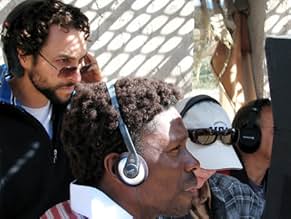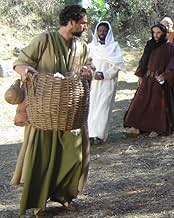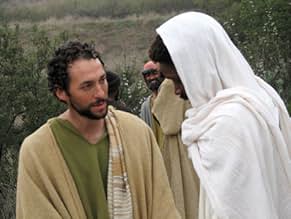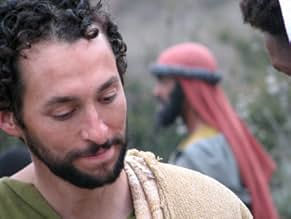Adicionar um enredo no seu idiomaA retelling of the events leading up to the crucifixion of Jesus Christ, based on the idea that he was a black man whose death was a racially motivated hate crime.A retelling of the events leading up to the crucifixion of Jesus Christ, based on the idea that he was a black man whose death was a racially motivated hate crime.A retelling of the events leading up to the crucifixion of Jesus Christ, based on the idea that he was a black man whose death was a racially motivated hate crime.
- Direção
- Roteiristas
- Artistas
- Direção
- Roteiristas
- Elenco e equipe completos
- Produção, bilheteria e muito mais no IMDbPro
Avaliações em destaque
I tried to see this film with high indulgence. And it has many good points, from the image of large family and the Pesah supper scenes to the racial perspective ( for the last, I ignored the difference between Hamitic and Semitic ). The only sin, in essence, is not inspired use of this point of view. The second big mistake - the dialogue , from fragmented message of Jesus to the innovations of scriptwriter. And , sure, the embarassing pieces of freedom of interpretation , from the presence of Saint Joseph to the relation between Saint Mary Magdalene and Judah or the attitudes against Romans. Sure, the image of Black Jesus , more than decent proposed by Jean Claude La Marre, is not wrong, but it impose a fair drive of it. Unfortunatelly, the color of skin becomes the only subject. But, sure, each film about The Savior is a personal testimony of director and his team. But it is fair to expect more than this supperficial aspect ruling a film about Him.
I had never heard of this and its sequel before the proprietor/friend of the DVD store I frequent mentioned them to me; being a radical and potentially controversial take on Christ's passion and death (nothing less would do after Mel Gibson's THE PASSION OF THE Christ {2004} I guess!), I opted to check them out over this Easter season.
However, I was not impressed: of course, the first two things that are immediately evident is that the protagonist's name has been given its 'correct' Jewish pronunciation of Yeshua (but, then, so did the notorious THE PASSOVER PLOT 30 years previously!) and that he is black (again, this was hardly new: BLACK Jesus {1968} and BROTHER JOHN {1971} – both of which I will be checking out presently – had depicted him as such too...though, admittedly, the events were usually approached in allegorical terms). Incidentally, this is the first time the actor playing Christ has also directed himself(!) – and still, one other novelty here is that Arimathea (pronounced here "Aramithea"!) has become the location where the narrative unfolds!
Anyway, the film presents the familiar story of intolerance, betrayal and sacrifice, with most of the famous characters intact and then some: in fact, here Mary and Joseph (Jesus' parents) are shown as having had other children as well, and they are all affected – in different ways – by his plight. Curiously enough, the film skimps entirely on Christ's trials – jumping from his arrest in Gethsemane (where Jesus' sudden and unwarranted over-emoting is quite jarring, by the way!) to the predictably bloody crucifixion on Golgotha: that said, the version I watched was about 20 minutes shorter than the official running-time of 108 (which, for all I know, may account for this 'missing' segment)!
The film's lack of a reputation suggests that it made no significant ripples when it emerged: the thoroughly amateurish production and deliberately realistic yet low-key nature may equally have had something to do with this.
However, I was not impressed: of course, the first two things that are immediately evident is that the protagonist's name has been given its 'correct' Jewish pronunciation of Yeshua (but, then, so did the notorious THE PASSOVER PLOT 30 years previously!) and that he is black (again, this was hardly new: BLACK Jesus {1968} and BROTHER JOHN {1971} – both of which I will be checking out presently – had depicted him as such too...though, admittedly, the events were usually approached in allegorical terms). Incidentally, this is the first time the actor playing Christ has also directed himself(!) – and still, one other novelty here is that Arimathea (pronounced here "Aramithea"!) has become the location where the narrative unfolds!
Anyway, the film presents the familiar story of intolerance, betrayal and sacrifice, with most of the famous characters intact and then some: in fact, here Mary and Joseph (Jesus' parents) are shown as having had other children as well, and they are all affected – in different ways – by his plight. Curiously enough, the film skimps entirely on Christ's trials – jumping from his arrest in Gethsemane (where Jesus' sudden and unwarranted over-emoting is quite jarring, by the way!) to the predictably bloody crucifixion on Golgotha: that said, the version I watched was about 20 minutes shorter than the official running-time of 108 (which, for all I know, may account for this 'missing' segment)!
The film's lack of a reputation suggests that it made no significant ripples when it emerged: the thoroughly amateurish production and deliberately realistic yet low-key nature may equally have had something to do with this.
It seems the producers of this film thought they needed to alter the Bible in order to make a story that is anti-racist, and promotes racial harmony. Just a pity they couldn't have chosen a story that was actually true and in the Bible (ie., God's judgment of leprosy on Aaron and Miriam for racism towards Moses' black wife).
So was Jesus black, white, or something in between? Who knows, and who cares! - the Bible never tells us, and no early historical records describe him. Furthermore no painting were ever done of Jesus until about 400 years after his death and resurrection - so we may never know what Jesus looked like. All we know is that he was a Jew, who would have looked like Jews of the Middle-East (ie. Yemenite Jews).
The movie alters the reason for Jesus' death by crucifixion, not unlike a joke I have heard about Jesus ("he must have been black because he was lynched by a mob of white Romans"!).
The movie is just lies and propaganda from people who fantasize about Jesus being the race they want him to be.
So was Jesus black, white, or something in between? Who knows, and who cares! - the Bible never tells us, and no early historical records describe him. Furthermore no painting were ever done of Jesus until about 400 years after his death and resurrection - so we may never know what Jesus looked like. All we know is that he was a Jew, who would have looked like Jews of the Middle-East (ie. Yemenite Jews).
The movie alters the reason for Jesus' death by crucifixion, not unlike a joke I have heard about Jesus ("he must have been black because he was lynched by a mob of white Romans"!).
The movie is just lies and propaganda from people who fantasize about Jesus being the race they want him to be.
The movie was great, but should not have used any pacifiers strictly bloodline facts, the Middle East and Africa before Rome was Black, Brown, Light Skined and Proud. The introduction of the non colored Jews came well after the slaughter of the original Jews decedents of the tribe of Judah. this statement shouldn't be a shock popular history is almost always re written by the ones in power to reflect themselves and blow up or burn the truth lick the Sphinx and other artifacts throughout history. Contrary to popular believes black is back the meek shall inherit the earth but with less cruelty, seek and you shall find the truth choose not and and continue with blindness. God Bless all.
I believe this movie is created at the time in our history to bring all families and churches together. We are all one therefore each have a right to see Jesus as He looked and acts to them. So I say thumbs up to Mr. LaMarre for showing everyone how Jesus fulfill the role as a man of color. Well I have to say this movie I would personally recommend to all Churches to take their congregation and let everyone have a review of how they feel about Jesus being portrayed as a man of Color. I have seen the movie and would go again to see the movie. I especially like the fact that it showed Jesus as a family man with sisters and brothers. Also, it showed how Joseph didn't leave his wife because of her divine revelation of carrying the Messiah. So I say again, go see the movie and discuss it with your church family and I believe you will find out just how people are thinking. This as I have said could truly bring Unity to the body of Christ. Because I believe that the most races day of the week is on Sunday in the Church.
Você sabia?
- ConexõesFollowed by Color of the Cross 2: The Resurrection (2008)
Principais escolhas
Faça login para avaliar e ver a lista de recomendações personalizadas
Detalhes
- Data de lançamento
- País de origem
- Central de atendimento oficial
- Idioma
- Empresa de produção
- Consulte mais créditos da empresa na IMDbPro
Bilheteria
- Orçamento
- US$ 2.500.000 (estimativa)
- Faturamento bruto nos EUA e Canadá
- US$ 85.802
- Fim de semana de estreia nos EUA e Canadá
- US$ 25.868
- 29 de out. de 2006
- Faturamento bruto mundial
- US$ 85.802
- Tempo de duração1 hora 48 minutos
- Cor
- Proporção
- 2.35 : 1
Contribua para esta página
Sugerir uma alteração ou adicionar conteúdo ausente


























